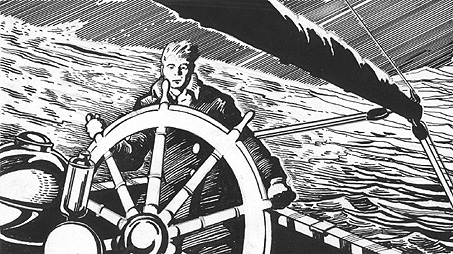|
|
South of Cape Horn:A Saga of Nat Palmer and Early Antarctic Explorationby Armstrong Sperry
|
[an error occurred while processing this directive]
|
|
South of Cape Horn:A Saga of Nat Palmer and Early Antarctic Explorationby Armstrong Sperry
|
From the dustjacket:
Whenever he could escape his mother's watchful ete, Nat Palmer would run into his father's shipyard. By the time Nat and his playmates were seven or eight they could handle a sailboat
With this background there is little wonder that Nat Palmer lived only for the day when he too could sail before the mast.
Here is Armstrong Sperry at his thrilling best, telling for the first time the story of Capt. Nathaniel Palmerm the man who gave his name to Palmer Peninsula in the Antarctic.
This is the true story of one of the United States first explorers. Complete with the drama of an adventure story, South of Cape Horn tells the story of a boy who became a seaman at fourteen and master of the Hero five years later. This was the ship Nat sailed toward the Antarctic where he discovered seal rookeries and whaling grounds that meant prosperity for a whole generation of New Englanders.
South of Cape Horn is an exciting story that soon casts a spell over the reader until he too imagines that he is fighting the elements with Nat and his crew, enjoying the pranks and gaiety of crossing the equator and taking part in the excitement of a seal hunt inthe Antarctic.
Here is a thrilling tale of the sea, told as only Armstrong Sperry can tell it, to delight any boy or girl.
![]() You can send this pen-&-ink illustration
as a free virtual postcard (#16)!
You can send this pen-&-ink illustration
as a free virtual postcard (#16)!

ARMSTRONG SPERRY, one of the outstanding historical novelists for young people in the United States, is the unusual combination of imaginative artist and gifted writer. His impressive number of published works has brought him many honors -- including the coveted John Newbery Award for Call It Courage.
Mr. Sperry was raised among the rocky hills of Connecticut, within sight of the Atlantic Ocean. It may have been the nearness of the ocean which aroused in him dreams of pirates, adventure, and faraway lands. These daydreams later emerged as stories and drawings. He cannot remember when he began to write and draw, but both forms of expression filled his earliest childhood and continued through his schooldays.
Art, though, held sway when the time arrived to prepare for a career. Mr. Sperry's initial formal training in this field was at Yale Art School, but this pursuit was interrupted by World War I and his service in the Navy. After the war, he attended the Art Student's League for three years and spent a magical winter in Paris. Then, feeling equipped to face the business world, the new artist secured a position with an advertising agency.
Over the span of two years, Mr. Sperry absorbed much about advertising, but a chance reading of a book on the South Seas effected a dramatic change in his life. All his boyhood fancies of ships and pirates and savages were rekindled. Consequently, a few months later, he found himself on a copra schooner that was sailing from Tahiti to Borabora, one of the Society Islands in French Oceania. At Borabora, he lived in a bamboo house near a lagoon, but went forth frequently to explore the surrounding islands. During these journeys, he learned about the peoples, their legends and music. This knowledge formed the basis for some of his most enchanting books.
Since Mr. Sperry is descended from a long line of sea captains, it is natural that many of his novels should have as their theme the sea and the courageous men who followed it. South of Cape Horn is the latest of his stories with a nautical flavor.
The inspiration for South of Cape Horn came in a roundabout fashion. The author was reading about the International Geophysical Year for 1957-58 and the Antarctic expeditions planned in conjunction with it, when he realized he had no idea who discovered that icy continent. Thus began an extensive search into the life of Nathaniel Brown Palmer, the man believed by many to be the first to have discovered the Antarctic Continent. Historians may someday disprove this particular claim, but, nonetheless, the actual feats accomplished by Nat Palmer were so incredible, Mr. Sperry felt compelled to write the story of this almost-forgotten American sea captain.
For more information about Capt. Nathaniel Palmer, visit the Stonington
(CT) Historical Society